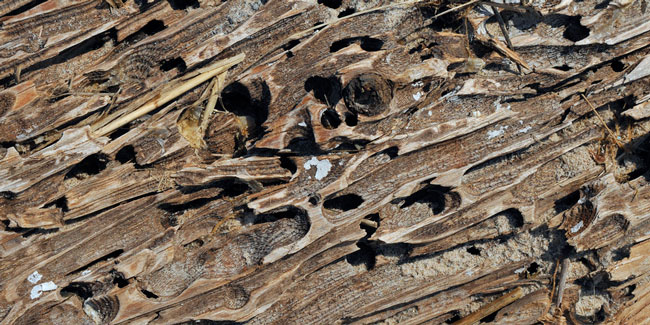What Does Termite Damage Look Like?
By Chris Williams on December 3, 2013.

Wood damage from termites
Question
Can you describe what termite damage looks like? I think that what we’re seeing in the wood paneling in our basement is from ants tunneling in the wood, but my wife thinks it’s termites. We haven’t seen any insects. We tried looking at pictures of damage online but it’s hard to tell the difference. Is there anything specific that we can look for?
Answer
There are differences between ant damage and termite damage, and some similarities, too. Several different types of ants can tunnel in wood, but the ones we’re most concerned about are carpenter ants. If you haven’t already done so, by breaking into the damaged wood, you can see the galleries and the damage.
In the Galleries, Neatness Counts
Ants don’t actually eat the wood, they just excavate it to make “galleries” for their nests. Carpenter ants are very neat in their work. Their galleries are smooth and clean, and feel like they’ve been sandpapered. Carpenter ants dump everything—sawdust, feces, dead ants, and bits of insulation or other debris—to the outside of the nest through a slit in the wood. Sometimes you will find this dump pile below the nest site. But other times, the debris is dumped inside a wall void instead.
Subterranean termites do eat the wood, and consequently, you find evidence of that in their galleries. What they leave behind in the wood is not neat and clean as it is with carpenter ants. The damaged wood will be plastered with a muddy mixture of yellowish-brown digested wood and soil. When it dries, it looks a bit like oatmeal. You may find narrow mud tubes leading from the infested wood to the soil where the termites live, or tubes packed into cracks or seams in the paneling.
Look at The Wood Damage
With both carpenter ants and termites, you usually don’t see any evidence of damage on the outside surface of the wood. On the surface of carpenter ant-damaged wood you might see slits that they use to expel wood and debris from the nest. Inside the wood, carpenter ant galleries are irregular rounded or elongate carved out depressions with rounded edges and smooth surfaces. There is no mud present as with termites and any sawdust has usually been ejected from the nest.
The surface of termite-damaged wood can have a blistered appearance. The wood inside has a honeycombed or layered look where the termites have preferentially eaten the softer springwood layers, leaving the harder layers of summerwood in between. In between this layered wood you will see the mud mentioned above. Since termites eat and digest the wood, there will be no sawdust present.
Whether it’s termites or carpenter ants, it could be old damage, or it could be from an active infestation. That’s something that you really need a professional to determine. Both pests usually infest wood that is damp or water-damaged so that’s another issue you may need to deal with. Whether it’s carpenter ants or termites, it’s a problem that needs to be addressed to protect your home. Our trained technicians can inspect your home and supply all the answers. Give Colonial a call.